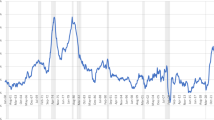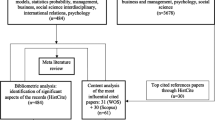Abstract
The Information Content of M3 for Future Inflation in the Euro Area. — The information content of M3 for future inflation in the euro area is investigated from a number of perspectives. Our results confirm that a significant positive association exists between the real money gap and future inflation up to five to six quarters ahead. It is also shown that, although the extended P-star model outperforms the rival model in some respect, the hypothesis that no useful information is contained in rival evidence can be rejected.
Similar content being viewed by others
References
Chong, Y. Y., and D. F. Hendry (1986). Econometric Evaluation of Linear Macro-Economic Models.Review of Economic Studies 53 (4): 671–690.
Clements, M. P., and D. F. Hendry (1996). Multi-Step Estimation for Forecasting.Oxford Bulletin of Economics and Statistics 58 (4): 657–684.
Coenen, G., and J. L. Vega (2001). The Demand for M3 in the Euro Area.Journal of Applied Econometrics 16 (6): 727–748.
Dolado, J. J., and H. Lütkepohl (1996). Making Wald Tests Work in Cointegrated VAR Systems.Econometric Reviews 15: 266–286.
Ericsson, N. R. (1992). Parameter Constancy, Mean Square Errors, and Measuring Forecast Performance: An Exposition, Extensions and Illustration.Journal of Policy Modeling 14 (4): 465–495.
Estrella, A., and F. S. Mishkin (1997). Is There a Role for Monetary Aggregates in the Conduct of Monetary Policy?Journal of Monetary Economics 40 (2): 279–304.
European Central Bank (1999). The Stability-Oriented Monetary Policy Strategy of the Eurosystem.ECB Monthly Bulletin (January): 39–50.
Fagan, G., J. Henry, and R. Mestre (2001). An Area-Wide Model (AWM) for the Euro Area. European Central Bank, Working Paper 42. Frankfurt/M.
Gerlach, S., and G. Schnabel (2000). The Taylor Rule and Interest Rates in the EMU Area: A Note.Economics Letters 67 (2): 165–171.
Gerlach, S., and L. E. O. Svensson (2000). Money and Inflation in the Euro Area: A Case for Monetary Indicators? BIS Working Paper 98, Basle (also published as NBER Working Paper 8255, Cambridge, Mass.).
Granger, C. W. J. (1988). Causality, Cointegration and Control.Journal of Economics, Dynamic and Control 12 (2-3): 551–558.
Groeneveld, J. M. (1998).Inflation Patterns and Monetary Policy. Lessons for the European Central Bank. Cheltemham: Edward Elgar.
Harvey, A.C, and A. Jaeger (1993). Detrending, Stylised Facts and the Business Cycle.Journal of Applied Econometrics 8 (3): 231–247.
Harvey, D. I., S. J. Leybourne, and P. Newbold (1998). Tests for Forecast Encompassing.Journal of Business & Economic Statistics 16 (2): 254–259.
Hendry, D. F., and J.-F. Richard (1989). Recent Developments in the Theory of Encompassing. In B. Cornet and H. Tulkens (ed.),Contributions to Operations Research and Econometrics. The XX Anniversary of CORE. Cambridge, Mass.: MIT Press.
Issing, O., V. Gaspar, I. Angeloni, and O. Tristani (2001).Monetary Policy in the Euro Area: Strategy and Decision-Making at the European Central Bank. Cambridge, UK.: Cambridge University Press.
King, R. G., and S. Rebelo (1993). Low Frequency Filtering and Real Business Cycles.Journal of Economic Dynamics and Control 17 (1-2): 207–231.
Miskhin, F. S. (1990). The Information in the Longer-Maturity Term Structure About Future Inflation.Quarterly Journal of Economics 105 (3): 815–828.
Mizon, G. E., and J. F. Richards (1986). The Encompassing Principle and Its Application to Testing Non-Nested Hypotheses.Econometrica 54 (3): 657–678.
Orphanides, A., and S. van Norden (2002). The Unreliability of Output Gap Estimates in Real Time. Board of Governors of the Federal Reserve System.The Review of Economics and Statistics, forthcoming.
Roberts, J. M. (1997). Is Inflation Sticky?Journal of Monetary Economics 39(2): 173–196.
Sims, C. A. (1972). Money, Income and Causality.American Economic Review 62 (4): 540–552.
Stock, J. H., and M. W. Watson (1999). Forecasting Inflation.Journal of Monetary Economics 44 (2): 293–335.
Taylor, J. B. (1999). A Historical Analysis of Monetary Policy Rules. In J. B. Taylor (ed.), (1999).Monetary Policy Rules. Chicago: The University of Chicago Press.
Toda, H. Y., and P. C. B. Phillips (1993). Vector Autoregression and Causality.Econometrica 63 (4) 1367–1393.
Toda, H. Y., and P. C. B. Phillips (1994a). Vector Autoregression and Causality: A Theoretical Overview and Simulation Study.Econometric Reviews 13 (2): 259–285.
Toda, H. Y., and T. Yamamoto (1994). Statistical Inference in Vector Autoregressions with Possibly Integrated Processes.Journal of Econometrics 66 (1-2): 225–250.
Tzavalis, E., and M. R. Wickens (1996). Forecasting Inflation from the Term Structure.Journal of Empirical Finance 3 (1): 103–122.
Woodford, M. (1994). Nonstandard Indicators for Monetary Policy: Can Their Usefulness Be Judged from Forecasting Regressions? In N. G. Mankiw (ed.),Monetary Policy. Chicago: University of Chicago Press for NBER.
Yamada, H., and H. Y. Toda (1998). Inference in Possibly Integrated Vector Autoregressive Models: Some Finite Sample Evidence.Journal of Econometrics 86 (1): 55–95.




